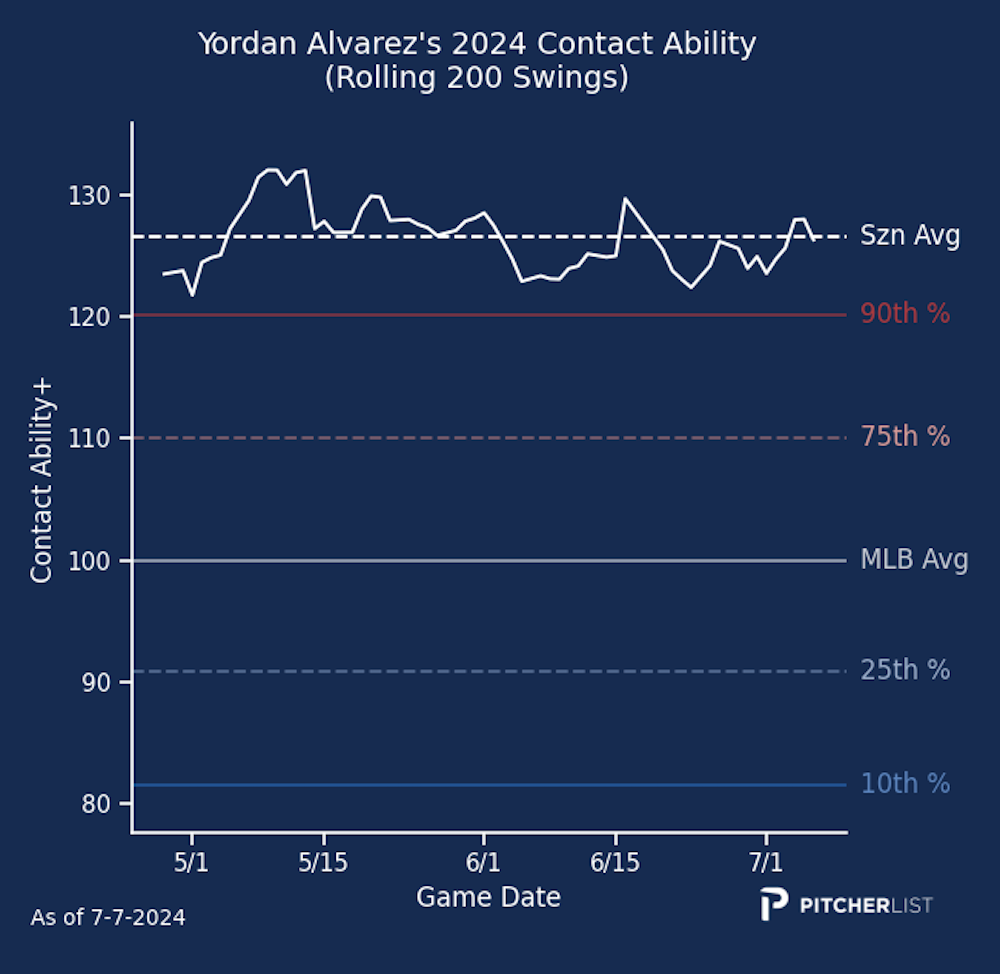Last week, we revealed who should start the NL All-Star game based on PLV statistics. This week, it’s the ALs’ turn, and we have the actual starting lineups to compare to this time.
Before we jump in, here’s a reminder of the criteria. Each hitter must have seen at least 1,000 pitches through June to qualify. The only exception was at catcher, which we lowered to 800. The Hitter Performance category was the dominant selection driver, but we looked at all the categories to find the players with the best overall PLV profiles. Like the official ballot, we went with three outfielders regardless of where they typically play and slotted them in left, right, and center based on the best fit. All of the stats below are through June 30.
Catcher: Connor Wong
Runners Up: Adley Rutschman, Ryan Jeffers, Salvador Perez
Adley Rutschman is the starter, and he deserves the recognition as he had the second-highest HP to Connor Wong and excellent Contact Ability and Power ratings. However, the Orioles’ backstop had very low SZ Judgement and Decision Value ranks, which pushed Wong slightly ahead of him in our eyes.
Wong has surpassed expectations this season, breaking out for the Bosox in a big way. The 28-year-old led AL catchers in OPS, wOBA, and wRC+ through June and would likely have higher counting stats if he played more often. A .384 BABIP buoyed Wong’s average, but he’s shown excellent command of the strikezone and better-than-expected power. His SZ lags only William Contreras and Patrick Bailey among qualified catchers and continues to rise.
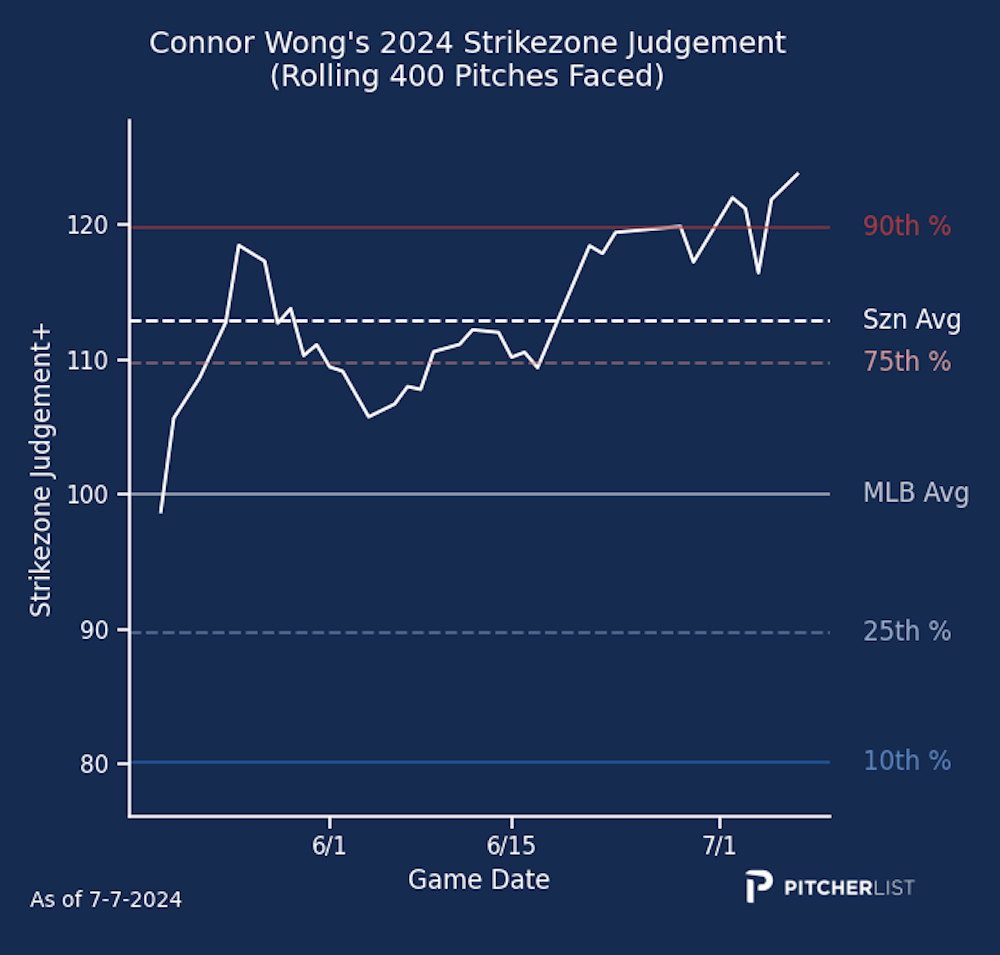
First Base: Vladimir Guerrero Jr.
Runners Up: Josh Naylor, Yandy Díaz
Vlad is the starter, and we concur. Josh Naylor and Yandy Díaz made good cases but not as compelling as Guerrero, who ranked well above average in every PLV category. The Blue Jays’ first-baseman has had an up-and-down career—at least according to expectations—but he’s been dialed in this season thus far. Vlad had the highest OPS, wOBA, and wRC+ at his position in the AL through June and lagged only Freddie Freeman and Bryce Harper among all first basemen in HP. He’s a rarity among hitters in that he has no clear weaknesses at the plate.
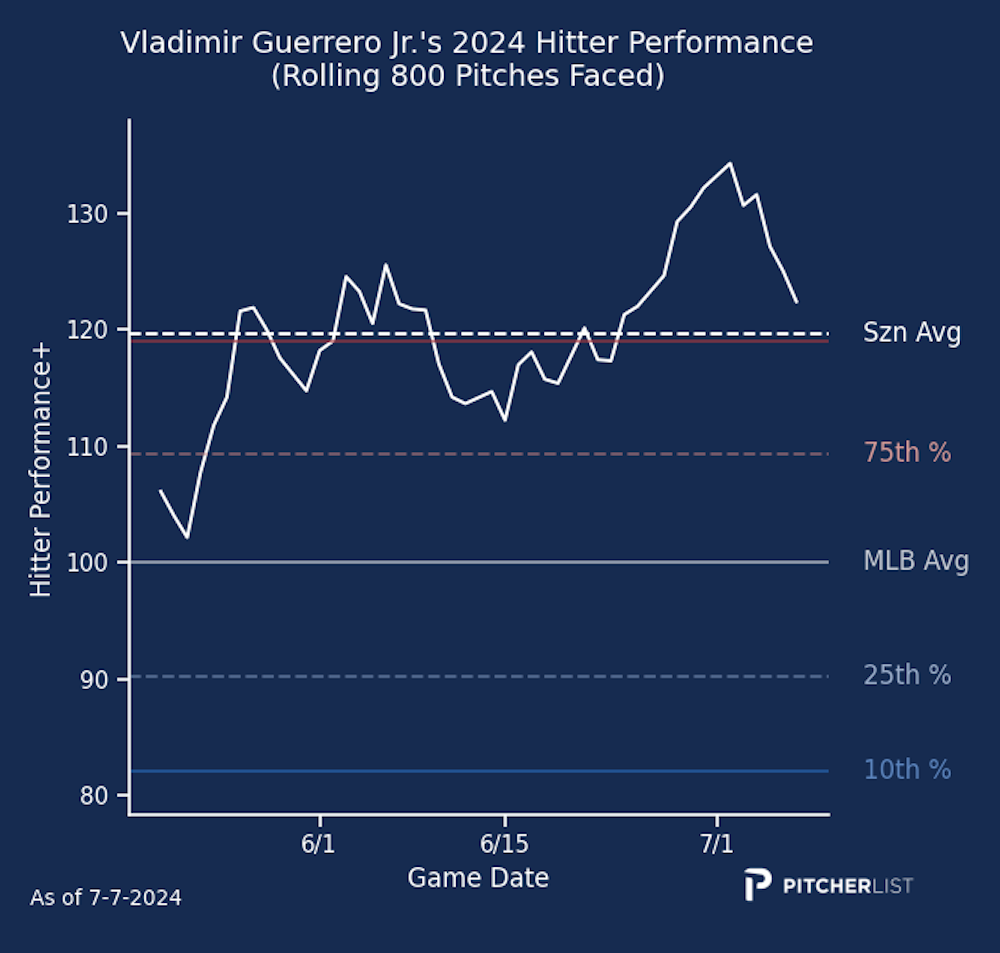
Second Base: Jordan Westburg
Runners Up: Jose Altuve, Marcus Semien
Jose Altuve is the starter and had an identical 118 HP to Jordan Westburg, so the veteran isn’t a terrible choice. However, Altuve has struggled with an 80 SZ and a 90 DV this season, whereas Westburg is below average in only one PLV category—Contact Ability. Even though Westburg has played more third base than second this year, he gets our vote. Semien has a weird line but deserves some recognition. The Ranger is among the best in the league in SZ Judgement but posted a 96 HP rating through June.
Westburg has taken a huge step forward in his sophomore season, leading AL second basemen in RBI, OPS, wOBA, and wRC+. His 13 HRs through June were tied with Altuve for the positional lead. The 25-year-old has legit power, and his 21.7% K% isn’t terrible for a young power hitter. If he can improve on his ability to put the bat on the ball – his Whiff% is on the high side at 29.6%— he could develop into yet another deadly young hitter in the Orioles’ arsenal.
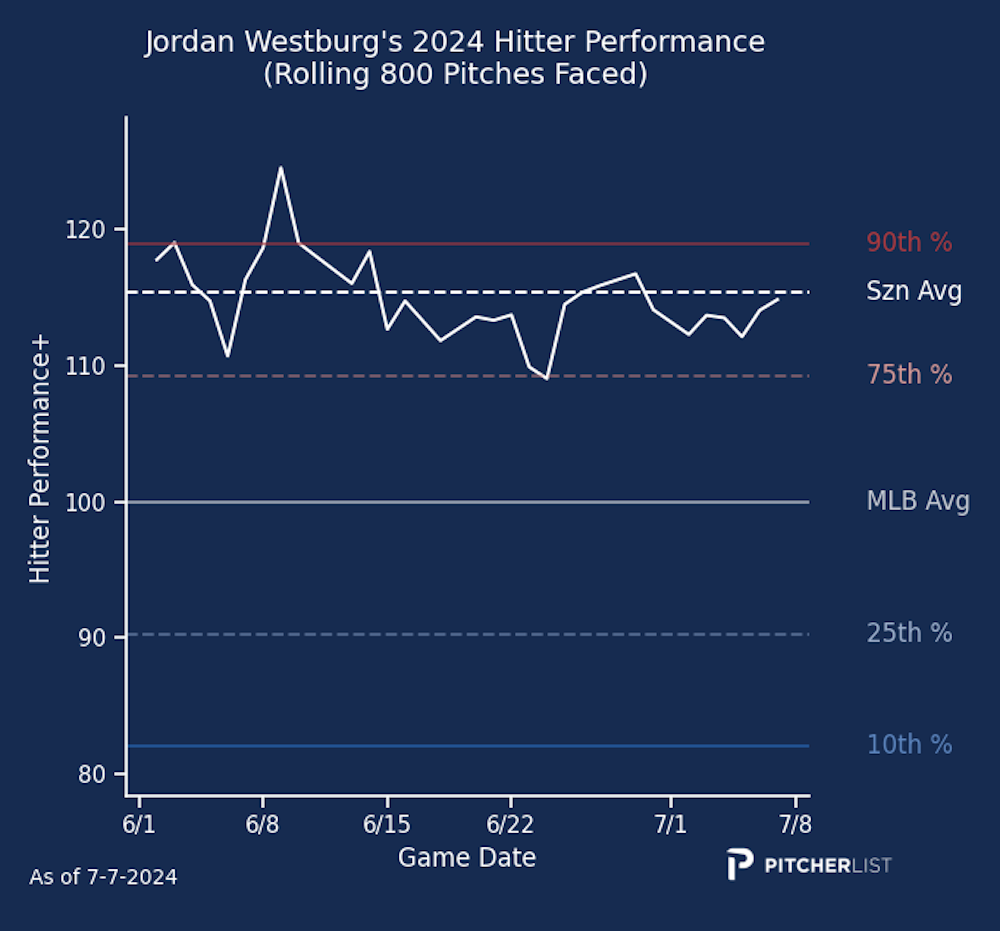
Shortstop: Gunnar Henderson
Runners Up: Corey Seager, Bobby Witt Jr., Carlos Correa
The American League is blessed with several amazing shortstops. Gunner Henderson has put up MVP year numbers thus far in his second season, and we agree with his selection as the All-Star starter. However, in PLV terms, Corey Seager, Bobby Witt Jr., and Carlos Correa have all been outstanding and are likewise deserving.
Like his teammate Jordan Westburg, Henderson’s only “weakness” this season—if you want to call it that—is his merely average ability to make contact. His power numbers are ridiculous. Only Aaron Judge had more h0mers than Gunnar through June (Ohtani was tied), and only Judge, Ohtani, and Kyle Tucker had a higher ISO. He’s not just a power hitter, though. Henderson ranks high in SZ and DV and has improved by his K% and BB% from his rookie season. He’s become a more patient hitter who doesn’t get cheated when he swings.
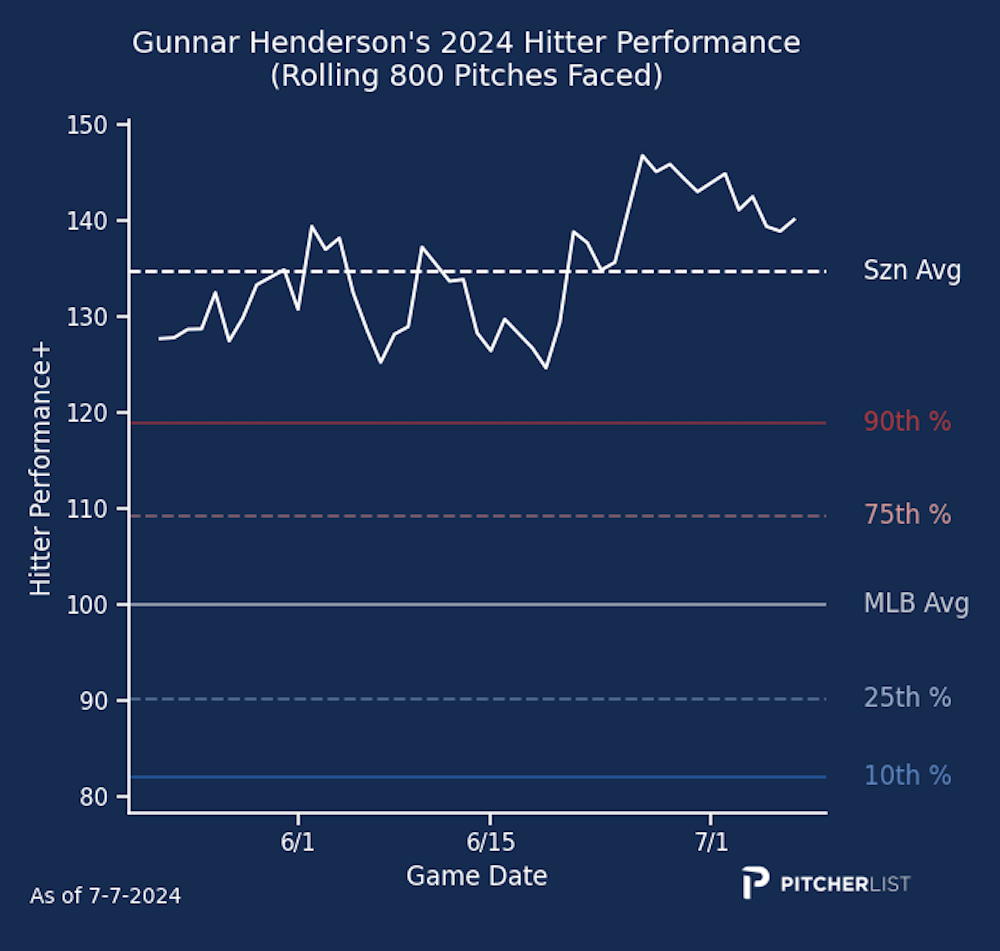
Third Base: Rafael Devers
Runners Up: Isaac Paredes, José Ramírez
José Ramírez got the starting nod, and it’s hard to argue with his production and Cleveland’s success, but in PLV terms, Rafael Devers edges him in our vote. The Red Sox third baseman had a higher Average, OBP, SLG, ISO, wOBA, and wRC+ than Ramirez, though he lagged in the counting stats due in part to ~40 fewer plate appearances. Isaac Paredes also warrants attention, thanks to his fantastic ability to make contact despite questionable plate discipline.
Devers has always displayed tremendous power, but he has kicked it up a notch this season – especially in June when he tallied a .648 SLG and .352 ISO. He makes tremendous contact, evidenced by a Barrel %, Exit Velocity, and Hard Contact % among the league leaders. Always an excellent hitter, Devers is on track to have the best offensive season of his career.

Left Field: Juan Soto
Selecting the starting AL outfielders was easy, as the three who made the cut were no-brainers. The first two, Yankees teammates Juan Soto and Aaron Judge, were voted in by the fans. The third, Kyle Tucker, isn’t starting—probably because he is currently injured.
Soto has been all that and more for the Yanks this season, putting up absurd numbers and combining with Judge to be the most lethal combo in MLB. Soto has always been a master decision-maker, and his 148 DV through June was the highest in MLB by a fair bit (numbers two and three were Judge and Tucker). Soto walks more than he strikes out on top of being one of the game’s premier power hitters. He had the most walks in baseball through June and was tied for seventh in HRs. Amazing!
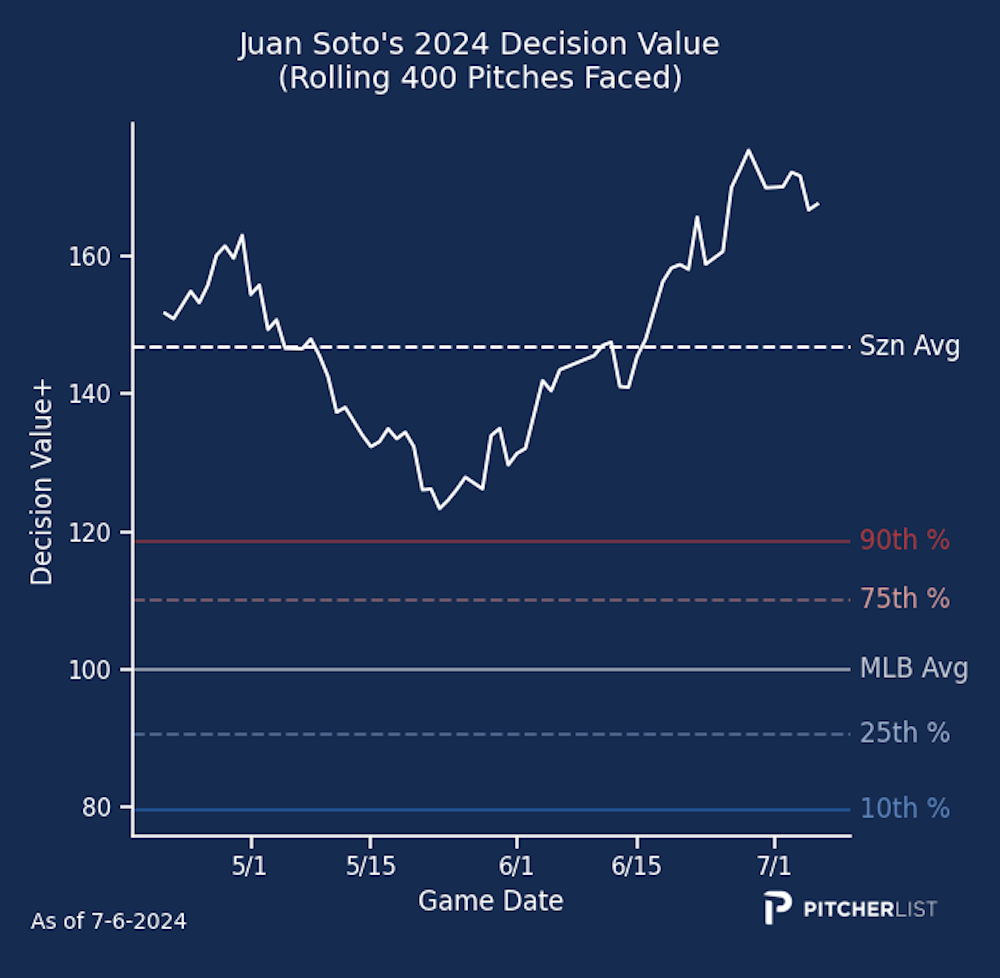
Center Field: Aaron Judge
If you’re a fantasy baseball player who drafted Aaron Judge, you may have been feeling buyer’s remorse around the end of April. Through the season’s first month, the big man was batting .207 with six HRs. Over the next two months, the Bombers leader more than redeemed himself, batting .384 with 25 HRs and 64 RBI. Despite the slow start, Judge is at or near the top in nearly every offensive category through June, including HRs, doubles, runs, RBI, Average, OBP, SLG, OPS, ISO, wOBA, and wRC+, to name a few. He swings and misses often, but it’s a small price to pay, considering the damage he inflicts when he makes contact.
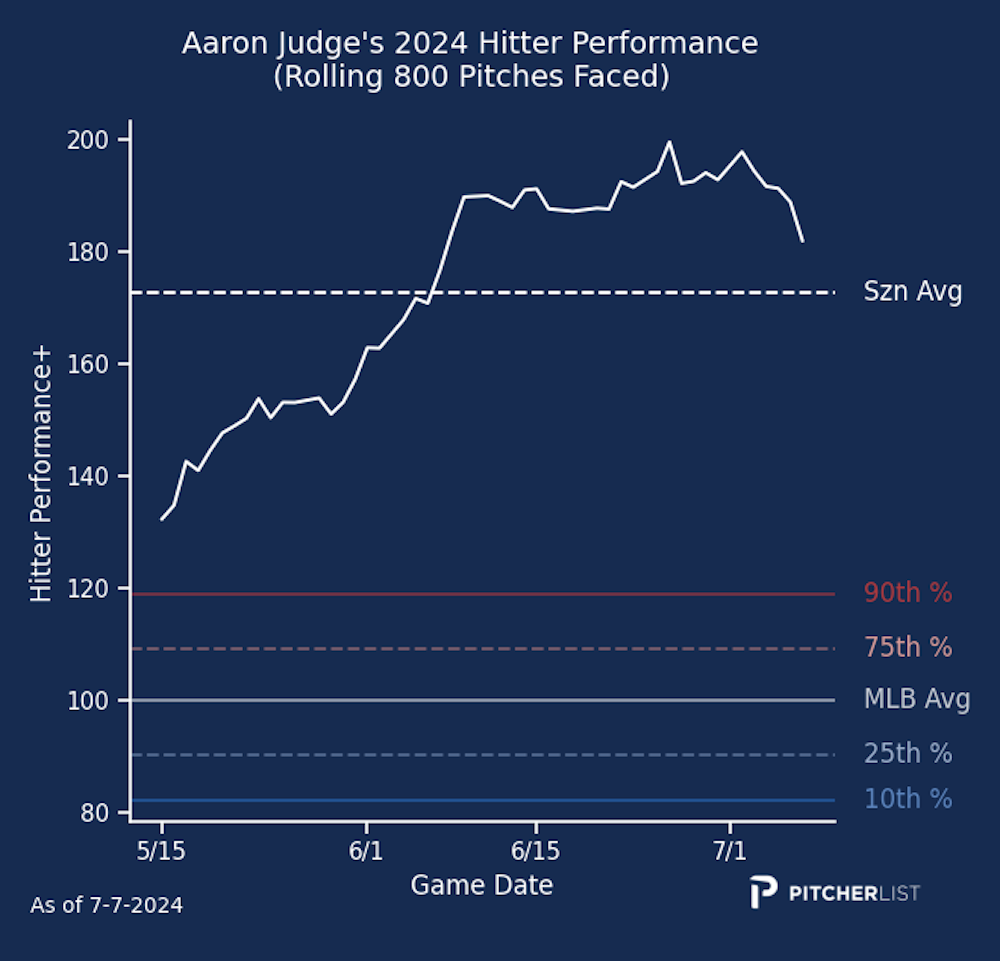
Right Field: Kyle Tucker
Tucker hasn’t played since early June, but he still qualified for our team, as he saw over 1,000 pitches before his injury. Steven Kwan got the nod from the fans, which is ironic since he had fewer plate appearances through June than Tucker. The Astros outfielder should be back after the All-Star break, which is great news for a team that has gone on a run in his absence.
Even missing most of June, Tucker still ranked seventh in the AL in home runs. Among averaging stats, he looks even better with an OPS, ISO, wOBA, and wRC+ among the AL leaders. His PLV ranks are high across the board, displaying a hitter with no weaknesses. We could have featured any of the PLV categories in the chart below, but we opted to display his tremendous SZ, which was second only to George Springer through June.

Designated Hitter: Yordan Alvarez
Runner Up: Brent Rooker
Brent Rooker gave Yordan Alvarez a run for his money in PLV terms, but in the end, we agreed with the voters that Alvarez should get the nod. Rooker’s Power ratings are impressive—second only to Judge in the AL—but Yordan’s overall profile was slightly better, and he had the higher HP.
Alvarez had a monster June, in which he slashed .349/.430/.709 amid the Astro’s surge. His PLV ratings are fascinating as he compensates for below-average plate discipline with a tremendous ability to put the bat on the ball. His 80.3% contact rate makes up for his tendency to sometimes chase pitches out of the zone, keeps his K% at a low 14.7%, and allows him to draw his fair share of walks. When he squares the ball up, he hits it hard, with a max EV among the highest in the AL. Alvarez is a complete and dangerous hitter, ranking in the 90th percentile in nearly every major statistical category.
